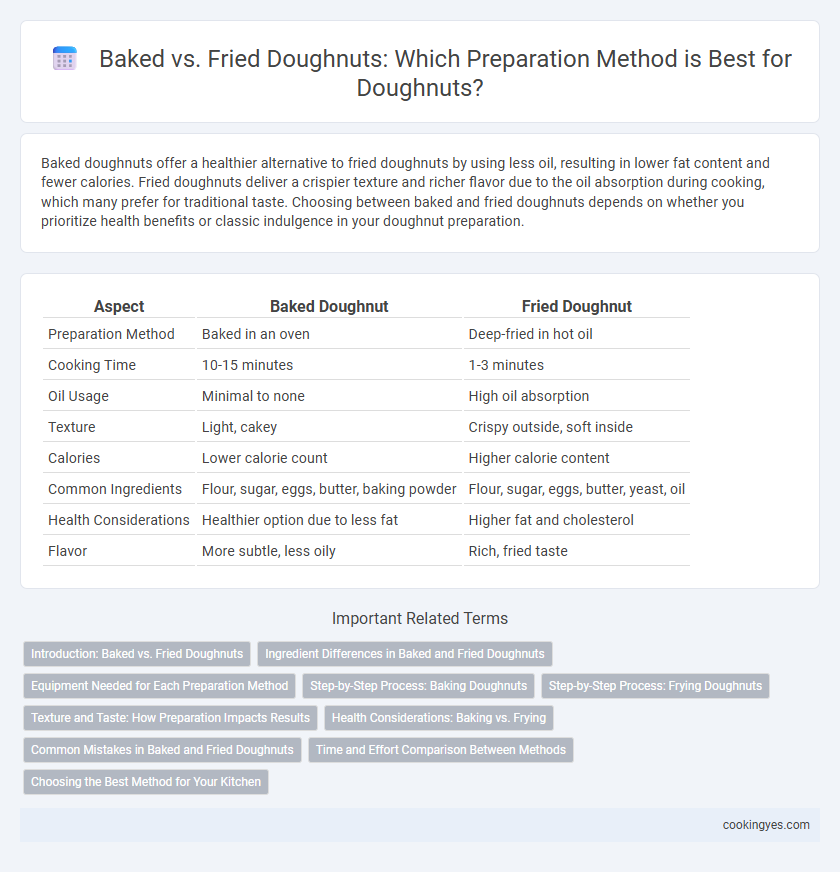Baked doughnuts offer a healthier alternative to fried doughnuts by using less oil, resulting in lower fat content and fewer calories. Fried doughnuts deliver a crispier texture and richer flavor due to the oil absorption during cooking, which many prefer for traditional taste. Choosing between baked and fried doughnuts depends on whether you prioritize health benefits or classic indulgence in your doughnut preparation.
Table of Comparison
| Aspect | Baked Doughnut | Fried Doughnut |
|---|---|---|
| Preparation Method | Baked in an oven | Deep-fried in hot oil |
| Cooking Time | 10-15 minutes | 1-3 minutes |
| Oil Usage | Minimal to none | High oil absorption |
| Texture | Light, cakey | Crispy outside, soft inside |
| Calories | Lower calorie count | Higher calorie content |
| Common Ingredients | Flour, sugar, eggs, butter, baking powder | Flour, sugar, eggs, butter, yeast, oil |
| Health Considerations | Healthier option due to less fat | Higher fat and cholesterol |
| Flavor | More subtle, less oily | Rich, fried taste |
Introduction: Baked vs. Fried Doughnuts
Baked doughnuts are prepared by baking the batter in a doughnut-shaped mold, resulting in a lighter texture and lower fat content compared to fried doughnuts, which are submerged in hot oil to achieve a crispy exterior and rich flavor. The baking process reduces oil absorption, making baked doughnuts a healthier alternative while maintaining a moist interior. Fried doughnuts typically offer a traditional taste and texture prized for its golden crust, though they contain higher calories due to oil frying.
Ingredient Differences in Baked and Fried Doughnuts
Baked doughnuts typically use less fat in their batter due to the absence of submersion in hot oil, often incorporating ingredients like yogurt or applesauce to maintain moisture and texture. Fried doughnuts require higher oil content or butter in the dough to achieve a crispy exterior and tender interior after frying in vegetable or canola oil. The ingredient differences highlight a lower calorie and fat content in baked doughnuts, while fried doughnuts leverage frying oil for flavor and texture enhancement.
Equipment Needed for Each Preparation Method
Baked doughnuts require an oven and specialized doughnut pans to shape the batter evenly, ensuring consistent baking. Fried doughnuts need a deep fryer or heavy pot filled with oil at a controlled temperature, along with a slotted spoon or wire rack for draining excess oil. Each method demands specific equipment to achieve the desired texture and flavor.
Step-by-Step Process: Baking Doughnuts
Baked doughnuts require preheating the oven to 350degF (175degC) and preparing a doughnut pan with non-stick spray to ensure easy release. The dough mixture, often lighter and less oily than fried doughnuts, is spooned or piped into the pan before baking for 10-12 minutes until golden brown and cooked through. This method uses hot air circulation to cook the doughnuts evenly, resulting in a tender, cake-like texture with less fat compared to the deep-frying process.
Step-by-Step Process: Frying Doughnuts
Frying doughnuts involves heating oil to around 350degF (175degC) before carefully submerging shaped dough to ensure even cooking and a golden-brown crust. The doughnuts typically cook for 1-2 minutes per side, during which they puff up and develop a crispy exterior contrasted with a soft, airy interior. Proper temperature control and timely flipping are crucial to avoid greasy or undercooked doughnuts and achieve the classic fried texture.
Texture and Taste: How Preparation Impacts Results
Baked doughnuts have a lighter, cakey texture due to the gentle heat evenly cooking the batter, resulting in a less oily and slightly drier taste compared to fried doughnuts. Fried doughnuts develop a crisp, golden exterior with a moist, tender interior as the hot oil rapidly seals the dough, enhancing richness and imparting a signature deep-fried flavor. The preparation method directly influences texture and taste, with baking promoting a delicate crumb and frying delivering a crispy bite and intensified flavor profile.
Health Considerations: Baking vs. Frying
Baked doughnuts offer a healthier alternative to fried doughnuts due to significantly lower oil absorption, reducing overall fat and calorie content. Frying doughnuts increases the risk of trans fats and acrylamide formation, compounds linked to heart disease and cancer. Choosing baked doughnuts supports better cardiovascular health and weight management while still delivering a satisfying texture.
Common Mistakes in Baked and Fried Doughnuts
Baked doughnuts often suffer from overmixing the batter, leading to dense and tough texture, while underbaking causes sogginess; ensuring proper oven temperature and timing is critical for a light crumb. Fried doughnuts commonly face issues like incorrect oil temperature, resulting in greasy or burnt exteriors, alongside improper dough resting which affects rising and texture. Both methods require precise control of ingredients and cooking conditions to achieve the ideal airy yet moist doughnut consistency.
Time and Effort Comparison Between Methods
Baked doughnuts require less preparation time and effort, as they avoid the lengthy oil heating and frying steps typical of fried doughnuts. The baking process is more hands-off, allowing doughnuts to cook evenly in the oven, while frying demands constant attention to maintain oil temperature and prevent overcooking. Overall, baked doughnuts offer a quicker, less labor-intensive alternative compared to the traditional fried method.
Choosing the Best Method for Your Kitchen
Baked doughnuts offer a healthier alternative by using less oil, resulting in lower fat content and easier cleanup in the kitchen. Fried doughnuts deliver the classic crispy texture and rich flavor that many consumers prefer, though they require more oil and specialized equipment. Choosing the best method depends on kitchen space, health considerations, and desired taste profile.
Baked doughnut vs Fried doughnut for preparation Infographic

 cookingyes.com
cookingyes.com